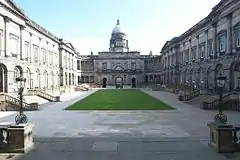Abertay University
Abertay University (formerly the University of Abertay Dundee), is one of two public universities in the city of Dundee, Scotland. In 1872, Sir David Baxter, 1st Baronet of Kilmaron, left a bequest for the establishment of a mechanics' institute in Dundee and the Dundee Institute of Technology was formed in 1888. As early as 1902 it was recognised by the Scottish Education Department as an educational hub, and was one of the first to be designated a central institution, akin to an 'industrial university'. Abertay gained University status in 1994.
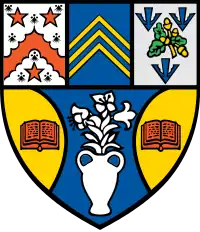 | |
| Motto | Latin: Beatus homo qui invenit sapientiam. |
|---|---|
Motto in English | "Blessed is the one who finds wisdom." |
| Type | Public |
| Established | 1994 - granted University Status 1888 - Dundee Institute of Technology |
| Chancellor | Alice Brown |
| Principal | Nigel Seaton |
| Chair of Court | Murray Shaw |
Academic staff | 208 |
Administrative staff | 300 |
| Students | 3,824[1] |
| Undergraduates | 3,501 |
| Postgraduates | 213 |
| Location | , 56°27′48″N 2°58′25″W |
| Colours | Blue, Red, Gold and Green |
| Affiliations | Million+[2] GuildHE[3] Universities Scotland[4] |
| Website | www |
 | |
Abertay launched the world's first computer games degree in 1997 and in 2017 held a programme of events celebrating 20 Years of Games. Abertay was also the first to offer a degree in Ethical Hacking, starting in 2006.
History
The following history to 1988 provides a summary account that relies primarily on the book published by Dundee Institute of Technology in 1989, 'The First Hundred Years: 1888-1988'.[5] Where additional sources have been used, post 1988, these have been cited accordingly.
The Baxter bequest (1872)
In 1872 Sir David Baxter, 1st Baronet of Kilmaron, died and bequeathed £20,000 (£1,581,200 adjusting for inflation) for the establishment of a mechanics' institute in Dundee. The Baxter bequest was intended to create an educational establishment permitting young (male) working mechanics and other craftsmen to better themselves. After some years of delay the trustees finalised a scheme and met the conditions of the bequest and the Dundee Technical Institute opened on 15 October 1888 in grounds, purchased from University College, Dundee, adjacent to Small's Wynd, Dundee. Initially 238 students enrolled and classes were conducted based on the syllabus of the Government Science and Art Department of South Kensington and the City & Guilds of London Institute. Subjects were primarily scientific and technical although applied art was also taught, and jute spinning and textile design were soon added to the portfolio.
In 1901 the Dundee Technical Institute enrolled 723 part-time students and was one of the first education hubs to be recognised as a 'central institution' by the Scotch Education Department. In 1906 a new site in Bell Street, Dundee was purchased to build a larger complex to accommodate a growing student population. In 1911 the completed complex was formally opened as the Dundee Technical College & School of Art. The portfolio had by now expanded again to include marine engineering and navigation.
The First World War retarded enrolments and growth but the vocational nature of the institute meant that its classes were highly relevant to the war effort. Records show that the first women students enrolled in 1914. After the war, the institute continued to expand adding a new school of pharmacy, and more specialist classes in engineering and building. Commercial classes in finance, economics and accounting were added to support trade at home and abroad.
The Duncan of Jordanstone bequest (1909)
In 1909 James Duncan of Jordanstone left £60,000 (£4,993,263 adjusting for inflation) to establish an art college in Dundee. It was only after a lengthy legal battle surrounding this bequest and the right of the existing college to spend the money, that a new scheme was entered into in 1933 permitting the establishment of the Dundee Institute of Art and Technology. The scheme allowed for separate technical and art colleges under a single governance framework. Plans for a new art college were drawn up in 1937. However, owing to the outbreak of the Second World War, plans were delayed and construction did not begin until 1953. The college of art became a formally separate institution, known as the Duncan of Jordanstone College of Art and Design, in 1975, remaining independent until 1994 when it became part of the University of Dundee.
First degrees (1951)
After the Second World War enrolments and the scope of delivery continued to expand, as did the reputation of the institute. By 1951 the institute was teaching courses that led to examinations for the external degrees of the University of London in pharmacy, mechanical, civil, and electrical engineering. In 1955 the National Council for Technological Awards was established and validated diplomas in technology which were equivalent in standard if not in name to honours degrees. In 1963 the Robbins Committee on Higher Education set out the principle that higher education should be available to all who wanted it and were suitably well qualified. The Committee recommended that the government should expand higher education in the UK, particularly in science and technology.
University status (1994)
Abertay University was created in 1994, under government legislation granting the title "University of Abertay Dundee" to the Dundee Institute of Technology. Since 2014 the University has promoted itself as Abertay University.[6] The university's name was formally changed to Abertay University by an Order of Council on 1 September 2019.[7]
Abertay was the first university in the world to offer a "computer games" degree in 1997.[8] Abertay was the UK's first University to be recognised as a Centre for Excellence in Computer Games Education, and is associated with a business support programme for computer game startups.[9][10]
Campus
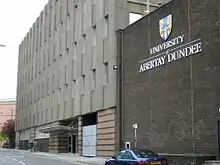
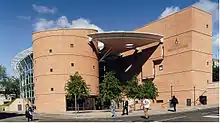
Abertay University is situated in the centre of Dundee. The campus buildings include the historic Old College buildings of Dundee Business School, the Bernard King Library, scenes of crime teaching facilities, specialist Ethical Hacking labs designed for research into computer hacking and misuse, and modern computer games labs in the UK Centre for Excellence in Computer Games Education.
The Bernard King Library in Bell Street opened to learners in February 1998 and was formally opened by Queen Elizabeth II on 30 June 1998. The library was voted best new building in Scotland in the 1998 Scottish Design Awards competition.[11] The building has a stone rectangular 'spine' and a curved glass front mimicking an open book. The Library houses an English Language learning centre, a specialist Law library, and an EU funded IT suite. The library was designed with the digital age very much in mind, and although the traditional books still feature, the emphasis was and is very much on providing access to digital information through online subscriptions.
The Student Centre building in Bell Street opened in 2005 providing a home to the Students' Association as well as a trading centre with an art gallery (Hannah Maclure Centre), cinema, student bars, food, and retail trading outlets.
Academic reputation
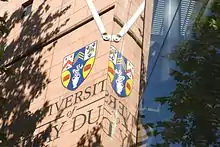
| National rankings | |
|---|---|
| Complete (2021)[12] | 103 |
| Guardian (2021)[13] | 87 |
| Times / Sunday Times (2021)[14] | 98 |
| Global rankings | |
| British Government assessment | |
| Teaching Excellence Framework[15] | Silver |
Abertay is a small university that receives the majority of its funding for teaching rather than research. Nevertheless, according to the results of the Research Excellence Framework 2014 (REF2014) published on 18 December 2014,[16] Abertay was the highest ranked modern university in Scotland for 'research intensity'.[17] The University submitted an increased proportion of staff in REF2014 compared to RAE2008 and achieved an average score of 2.15 - which in REF terms means 'quality that is recognised internationally in terms of originality, significance, and rigour'. This was an improvement from the average score of 1.83, 'national recognition', achieved in RAE2008.
Submissions were made in:
- Unit 4 Psychology, Psychiatry and Neurosciences
- Unit 5 Biological Sciences
- Unit 7 Earth Systems and Environmental Sciences
- Unit 15 General Engineering
- Unit 20 Law
- Unit 23 Sociology
- Unit 26 Sport and Exercise Sciences, Leisure and Tourism
Abertay submitted 30% more staff in REF 2014 than in RAE 2008, in seven Units of Assessment (UoAs) compared to six in 2008. Abertay submitted to three Units of Assessment for the first time: Sports Science, Sociology, and Biological Sciences. Abertay scored a proportion of research as 4* in six of the seven UoAs in 2014, compared to only two out of the six units submitted in 2008. Abertay submitted 36% of its academic staff to the REF.
Abertay was the first university in the world to offer a "computer games" degree in 1997.[18] In 2009 it established the UK's first Centre for Excellence in Computer Games Education, and a business support programme.[9][19] Abertay runs five of the 25 interactive and games degree courses accredited in the UK by Creative Skillset, the industry skills body for the creative sector, more than any other institution.[20]
External accreditation
Abertay is externally peer reviewed under the Enhancement-led Institutional Review (ELIR) method by the Quality Assurance Agency for Higher Education, Scotland (QAAS), on behalf of the Scottish Funding Council (SFC). All provision is benchmarked to the Scottish Credit and Qualifications Framework (SCQF).
In addition, Modules and Programmes offered at Abertay currently have been accredited by the following professional bodies:
Association of Chartered Certified Accountants; Association of International Accountants; British Association for Counselling and Psychotherapy; British Computer Society; British Council; British Psychological Society; Chartered Institute of Management Accountants; Chartered Institute of Personnel and Development; Chartered Institution of Water and Environmental Management; Counselling and Psychotherapy Scotland; Faculty of Advocates; Forensic Science Society; Health and Care Professions Council; Higher Education Academy; Institute of Biomedical Science; Joint Audio Media Education Services; Joint Board of Moderators; Law Society of Scotland; Nursing and Midwifery Council; Royal Society of Chemistry; Skillset
Research organisation
Research themes
Research at the University is organised into four main themes.
- Creative Industries
- Environment
- Security
- Society
Each theme is associated with areas of expertise.
The creative industries research theme focuses on: games research; digital cultures; and digital living. The environment research theme focuses on: environmental science and engineering; food science and innovation; environmental and systems biology; and sustainable technology. The security theme on: cyber security; forensic psychobiology; forensic sciences; and law. The society theme on: business, economics and management; the law of employment; media and culture; mental health and wellbeing; psychology; sociology; and sport performance and exercise.
Governance
The University was established by a statutory instrument The University of Abertay Dundee (Scotland) Order of Council 1994.[21] The Order sets out the objects of the University and the general functions of the University Court to 'conduct the affairs of the University and carry out and promote its objects'. The Order requires that the University Court makes arrangements for a Principal to be appointed to 'discharge the functions of the University Court (other than those delegated to Senate by virtue of article 36(3) of the Order) relating to the organisation and management of the University and to the discipline therein'. The Order requires that the University Court appoints and maintains a Senate, delegating to it 'the functions of the University Court relating to the overall planning, co-ordination, development and supervision of the academic work of the University; and such other functions of the University Court as may be assigned to the Senate by the University Court'.
Notable features
Computer games education
Abertay was the UK's first University to be recognised as a Centre for Excellence in Computer Games Education.
The Centre for Excellence is accredited by Skillset[22][23] and has strong links with industrial partners from across the broadcast, interactive and wider digital media sectors. These partners include BBC Scotland, BBC Vision, BSkyB, Channel 4, Electronic Arts, Codemasters, Blitz Games Studios, Rare, Sony Computer Entertainment Europe, Microsoft and Disney Interactive.
Ethical Hacking and Cyber-Security
Abertay was the first university in the world to have a degree in Ethical Hacking, differentiating from its other cyber-security degree counterparts by taking a more offensive approach to security. The university began to offer this degree in 2006.[24] In 2020 the university was one of eight in the UK, and the only one in Scotland, to be named an Academic Centre of Excellence in Cybersecurity by the National Cybersecurity Centre. [25]
The university is also home to the Ethical Hacking society, which hosts the Securi-Tay conference, the largest student-run security conference in Europe.[26][27]
Sport
Abertay University has a wide group of sports teams competing under the university banner. It ranges from Tennis to Hockey who compete in the BUCS (British Universities & Colleges Sport) leagues, which competes against other universities and colleges in Scotland. The Football, Hockey and Basketball teams have their 1st teams competing in the highest league (BUCS 1A). The University has a fierce rivalry with Dundee University, competing in a yearly Varsity competition. There are numerous notable athletic alumni that have undertaken their degrees in the University with the University facilitating elite sports men and women, who have either represented their country or compete at a high level.
Electives for the 21st century
An electives scheme provides opportunities, from 2015/16, for all early years students to broaden their intellectual horizon beyond the standard single or joint Honours degree combinations on offer.
Symbols
Coat of arms
Prior to 1953 no coat of arms was registered in the name of the college. The original Ensigns Armorial were recorded in the Public Register of All Arms and Bearings in Scotland on 25 July 1953, in the name of Dundee Technical College. They were subsequently transferred to Dundee College of Technology in 1977, then to Dundee Institute of Technology in 1988 and, finally, to the University of Abertay Dundee on 25 April 1994.
The arms are described as: "Party per fess, in chief tierced in pale: 1st, Ermine, a chevron engrailed between three mullets Gules; 2nd, Azure, three chevronels Or; 3rd, Argent, a spray of oak Proper fructed Or between three pheons Azure; in base Azure, a pot of three flowering lilies Argent between two flanches Or each charged with a book Gules."
The top left sector is taken from the arms of Sir David Baxter of Kilmaron, who bequeathed a significant sum of money in order to establish the original Dundee Technical Institute in 1888. The top right sector is taken from the arms of Sir William Dalgleish, who was the senior trustee of what by then was known as Dundee Technical College and School of Art, and who opened the first building – Old College – on Abertay's present campus on Bell Street in 1911. The top middle sector of three chevrons is the heraldic symbol for "technical". The pot of lilies in base is taken from the arms of the City of Dundee, with the books on either side representing education.
Motto
Beatus homo qui invenit sapientiam (Blessed is the one who finds wisdom).
Tartan
Aaron McCauley, a graduate of Abertay, designed and registered the Abertay tartan in 2003. The tartan is based on Abertay's promotional colours of dark blue, red, gold and green from its coat of arms.[28]
Student life
Accommodation
- Lyon Street
- Meadowside Hall
- Keiller Court
- Parker House - iQ Student Accommodation
Students' centre
The student centre building was constructed in 2005 at a cost of £6 million. It provides a focal point for student entertainment and recreation and contains numerous outlets including Aroma coffee bar, the Common Room E-Bar and Campus Shop.[29]
The Abertay Students' Association (Abertay SA) is based in the second floor of the Kydd building. Abertay SA co-ordinates all societies and acts as the voice and representation of all of Abertay's students.
Notable alumni and staff
- Shehzad Afzal, Game designer
- Roger Ball, musician, founding member Average White Band
- Vikki Bunce, Scottish hockey player
- Victoria Drummond MBE, first female Merchant Navy engineer in Britain
- Malcolm Duncan, musician, founding member Average White Band
- Joe FitzPatrick, Scottish National Party MSP, Scottish Government Minister for Parliamentary Business
- Stewart Hosie, Scottish National Party MP
- David Jones, DMA Design founder – now Rockstar North - creator of GTA and Lemmings franchises
- Bella Keyzer (1922 – 1992) Women's equality icon was retrained at Dundee Technical College to be a shipyard welder in 1976.[30]
- Andrew Mackenzie, Verdant Gin founder
- Maurice Malpas, Scottish football player and manager, spent his entire professional playing career at Dundee United F.C. and was capped for the Scotland national football team 55 times
- Iain McNicol, General Secretary of the Labour Party (UK)
- Stuart McMillan, Scottish National Party MSP
- Andy Nicol, Scottish Rugby Union player, team captain; also represented the Barbarians and British Lions
- Jude Ower MBE, Playmob founder
- Gavin Clydesdale Reid, economist and past President of the Scottish Economic Society (1999–2002)
- William Samson, former staff member and Scottish astronomer, mathematician, and computer scientist
- Tom Smith, Scottish Rugby Union player and coach, also represented Northampton Saints and British Lions
- Dr John N. Sutherland, former Professor of Virtual Reality, Gifu University, Japan.
- Sir Brian Souter, Stagecoach founder
- Liam Wong, graphic designer, game developer and photographer
References
- "Abertay integrated Report 2017" (PDF).
- "Archived copy". Archived from the original on 9 March 2016. Retrieved 9 March 2016.CS1 maint: archived copy as title (link)
- http://www.guildhe.ac.uk/members/
- "Member Universities - Universities Scotland".
- Dundee Institute of Technology (1989). The First Hundred Years: 1888-1988.
- Laurie Taylor (3 June 2014). "You make me feel brand new". Times Higher Education. Retrieved 13 December 2014.
- Abertay University (Scotland) Order of Council 2019
- "How Dundee became a computer games centre". BBC News. BBC. 9 October 2014. Retrieved 13 December 2014.
- "Abertay University £3 million funding for computer excellence". computescotland.com. 10 February 2009. Retrieved 13 December 2014.
- "Money for computer games centre". BBC News. BBC. 10 February 2009. Retrieved 13 December 2014.
- Hunter, Philip (19 December 1998). "Down your way: University of Abertay Dundee library". ARIADNE magazine. Retrieved 5 April 2015.
- "University League Table 2021". The Complete University Guide. 1 June 2020.
- "University league tables 2021". The Guardian. 5 September 2020.
- "The Times and Sunday Times University Good University Guide 2021". Times Newspapers.
- "Teaching Excellence Framework outcomes". Higher Education Funding Council for England.
- "Results & submissions : REF 2014". Retrieved 22 December 2014.
- Jump, Paul (1 January 2015). "REF 2014 rerun: who are the 'game players'?". Times Higher Education. Retrieved 14 February 2015.
- "How Dundee became a computer games centre". BBC News. BBC. 9 October 2014. Retrieved 13 December 2014.
- "Money for computer games centre". BBC News. BBC. 10 February 2009. Retrieved 13 December 2014.
- "Accredited Games and Interactive courses". Creative Skillset. Retrieved 4 February 2015..
- "University of Abertay Dundee (Scotland) Order of Council 1994". Retrieved 4 February 2015.
- "Computer Games Industry Accredited Courses". London: Creative Skillset. Archived from the original on 11 April 2013.
- "Accredited Computer Games courses: University of Abertay Dundee". London: Creative Skillset. Archived from the original on 12 July 2012.
- McCurdy, Rebecca. "Abertay University's top change-maker named following public vote". The Courier. Retrieved 19 May 2020.
- Raywood, Dan (16 December 2020). "NCSC Names Academic Centers of Excellence in Cybersecurity Education". Infosecurity Magazine. Retrieved 22 January 2021.
- "Abertay Set to Host Europe's Largest Student Cybersecurity Conference". Digit. 26 February 2020. Retrieved 19 May 2020.
- Peakin, Will (1 March 2019). "UK's largest student-led cybersecurity conference opens". FutureScot. Retrieved 19 May 2020.
- "Abertay checks in". Times Higher Education. 30 January 2004. Retrieved 8 February 2015.
- "Campus: Student Centre". University of Abertay Dundee Students' Association. Archived from the original on 11 April 2015. Retrieved 29 October 2012.
- Ewan, Elizabeth L.; Innes, Sue; Reynolds, Sian; Pipes, Rose (27 June 2007). Biographical Dictionary of ScottishWomen. Edinburgh University Press. p. 196. ISBN 978-0-7486-2660-1.
External links
| Wikimedia Commons has media related to University of Abertay. |
